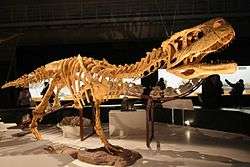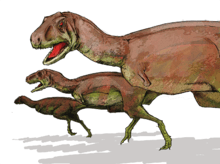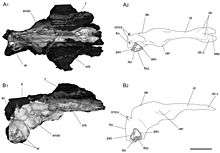Aucasaurus
| Aucasaurus Temporal range: Late Cretaceous, 83 Ma | |
|---|---|
 | |
| Mounted skeleton reconstruction | |
| Scientific classification | |
| Kingdom: | Animalia |
| Phylum: | Chordata |
| Class: | Reptilia |
| Clade: | Dinosauria |
| Order: | Saurischia |
| Suborder: | Theropoda |
| Family: | †Abelisauridae |
| Tribe: | †Carnotaurini |
| Genus: | †Aucasaurus Coria, Chiappe & Dingus, 2002 |
| Type species | |
| Aucasaurus garridoi Coria, Chiappe & Dingus, 2002 | |
Aucasaurus was a genus of medium-sized theropod dinosaur from Argentina that lived during the Santonian - Campanian stage of the Anacleto Formation. It was smaller than the related Carnotaurus, although more derived in some ways, such as its extremely reduced arms and almost total lack of fingers.[1] The type skeleton is complete to the thirteenth caudal vertebra, and so is relatively well understood, and is the most complete abelisaurid yet described. However, the skull is damaged, causing some paleontologists to speculate that it was involved in a fight prior to death.
Description

Aucasaurus short, deep-snouted skull was not as short or as deep-snouted as that of Carnotaurus. Also, instead of horns, it had a pair of low ridges above each eye.[2]
In 2016, its length was estimated as 6.1 metres (20 ft).[3] Gregory S. Paul had previously estimated its weight at 700 kg.[4]
Forelimbs and hands
Aucasaurus small arms were also alike that of its horned relative, but were proportionally longer due to its small size, and the bones lacked the bony processes and some unusual proportions present in Carnotaurus. The hand of Aucasaurus was unusual: four metacarpals were present, but the first and fourth lacked fingers. The second and third had fingers, but they were quite short and had no claws.[2]
Discovery
Aucasaurus is known from finds in the Rio Colorado Formation, a Late Cretaceous formation in Argentina that has yielded many dinosaur fossils. Numerous sauropod eggs are also known from this deposit.[2]
Classification

Aucasaurus was closely related to Carnotaurus and they are united in the Carnotaurini.[2]
Below is a cladogram by Canalle et al. in 2009.[5]
| Carnotaurinae |
| ||||||||||||||||||||||||||||||
| |
See also
References
- ↑ Coria, R. A.; Chiappe, L. M.; Dingus, L. (2002). "A new close relative of Carnotaurus sastrei Bonaparte 1985 (Theropoda: Abelisauridae) from the Late Cretaceous of Patagonia". Journal of Vertebrate Paleontology. 22 (2): 460. doi:10.1671/0272-4634(2002)022[0460:ANCROC]2.0.CO;2.
- 1 2 3 4 Benton, Michael J. (2012). Prehistoric Life. Edinburgh, Scotland: Dorling Kindersley. p. 320. ISBN 978-0-7566-9910-9.
- ↑ Grillo, O. N.; Delcourt, R. (2016). "Allometry and body length of abelisauroid theropods: Pycnonemosaurus nevesi is the new king". Cretaceous Research. doi:10.1016/j.cretres.2016.09.001.
- ↑ Paul, G.S., 2010. The Princeton Field Guide to Dinosaurs. Princeton University Press. p. 79.
- ↑ Canale, J. I.; Scanferla, C. A.; Agnolin, F. L.; Novas, F. E. (2008). "New carnivorous dinosaur from the Late Cretaceous of NW Patagonia and the evolution of abelisaurid theropods". Naturwissenschaften. 96 (3): 409–414. Bibcode:2009NW.....96..409C. doi:10.1007/s00114-008-0487-4. PMID 19057888.
External links
- The Theropod Database on Aucasaurus
- Thescelosaurus! on Aucasaurus